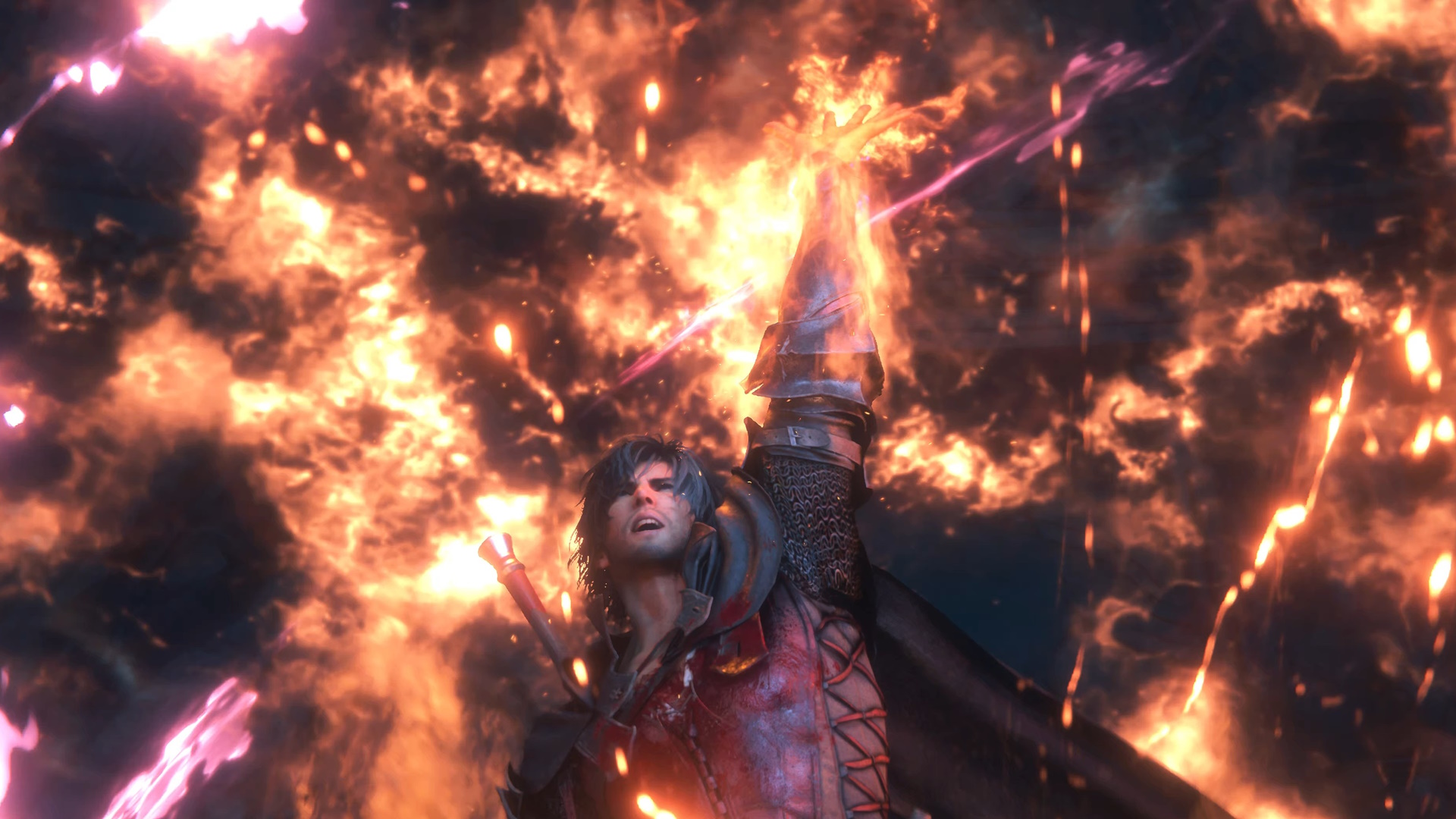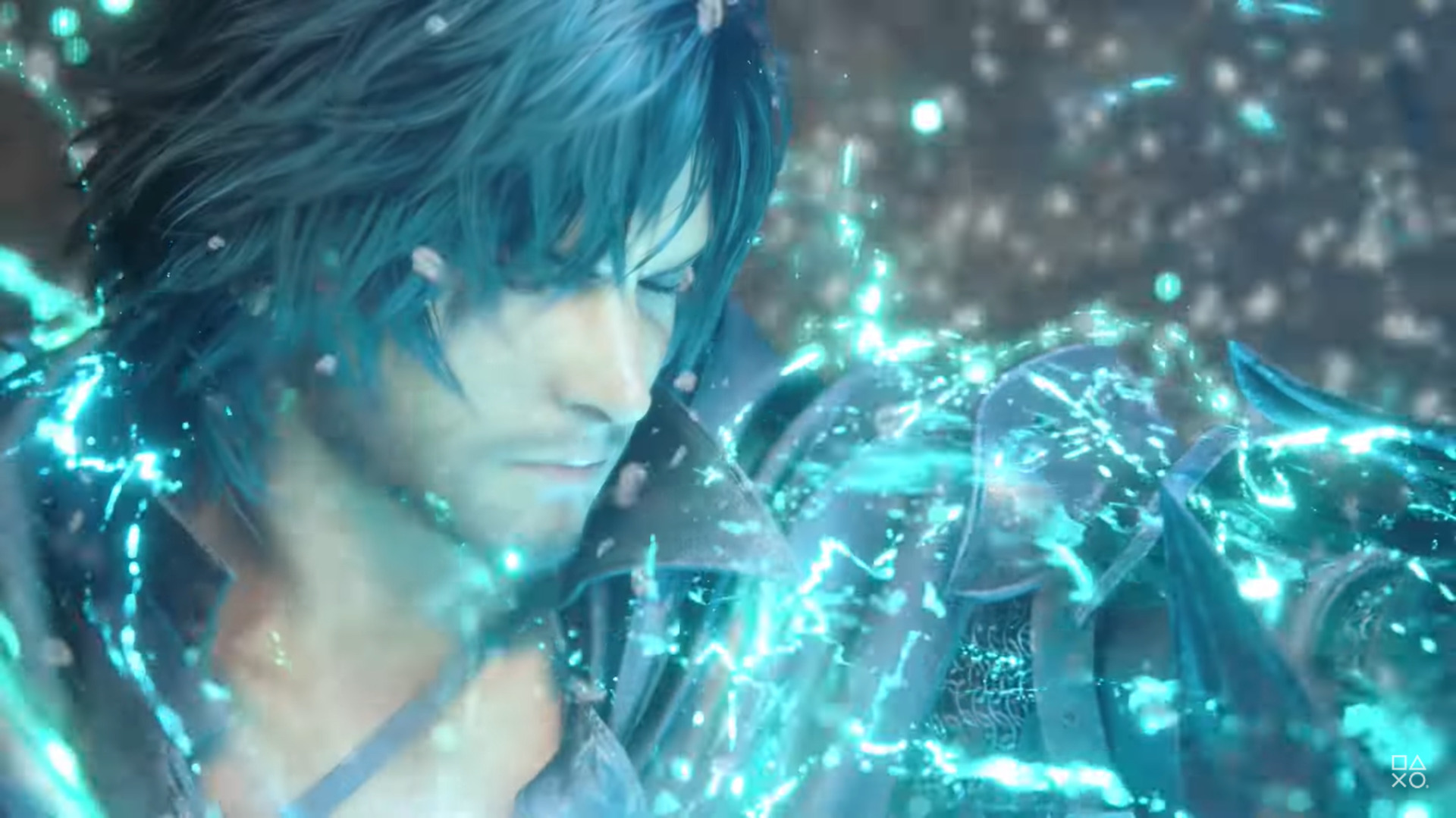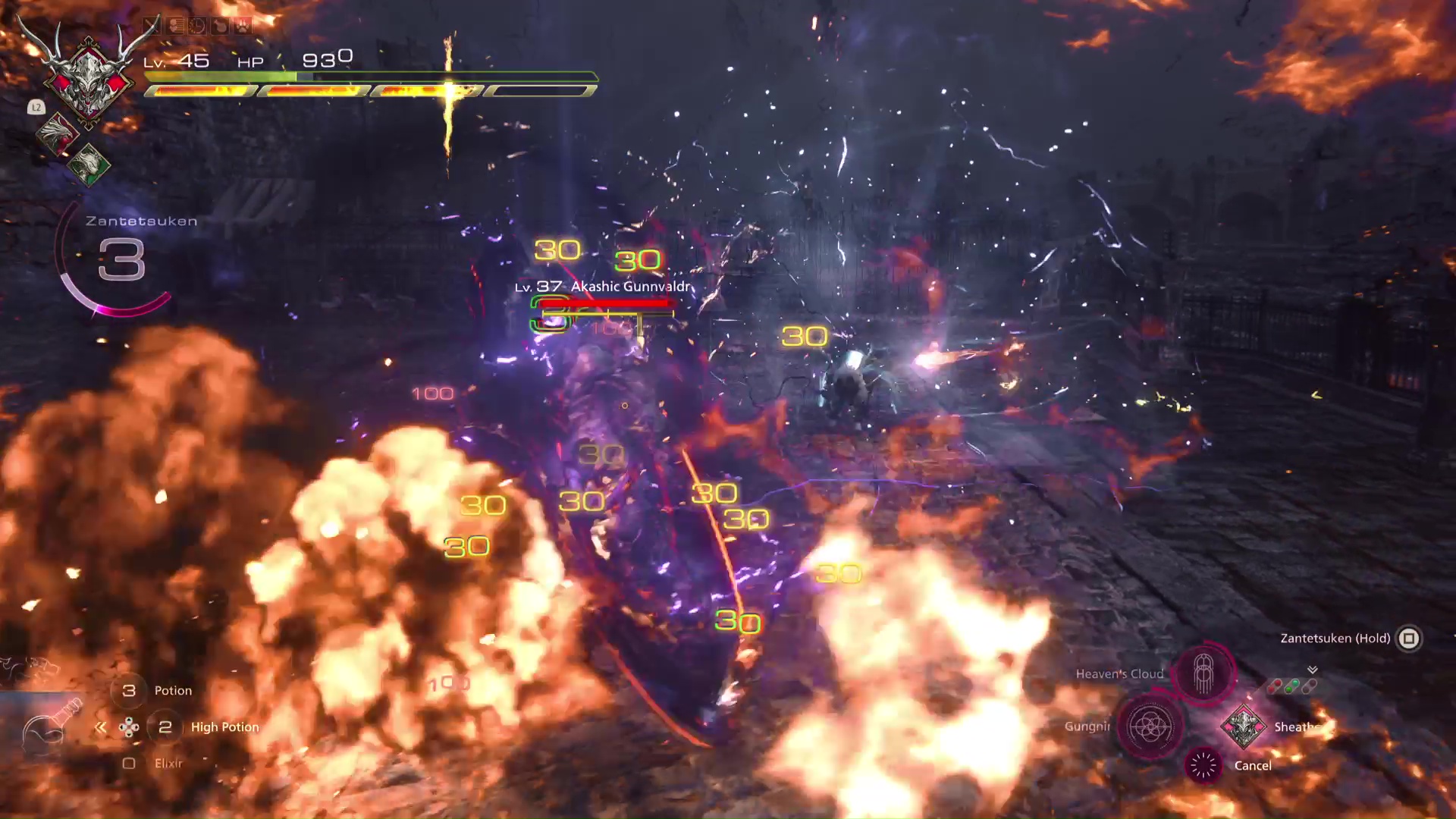
The words 'Final Fantasy' might have become something of a misnomer over the decades, this venerable series having spanned some 36 years and 16 releases (not counting the innumerable spinoffs, remakes, expansions, and sub-sequels such as FFX-2). Yet look closer at any given mainline instalment and there is a certain, well, finality to be found. After all, each Final Fantasy has a new world, story and systems – which means that, unless it's one of those that gets the spinoff treatment, it may very well also be the last outing for all those things too.
Perhaps no instalment in this series, though, has so clearly put the past behind it as Final Fantasy 16. That was apparent right from the game's initial reveal in 2020, which defiantly set out its stall as a radical departure. Here was a mature fantasy story unafraid to shed blood (or clothing), that ditched the traditional customisable party in favour of a single protagonist, Clive Rosfield, and, perhaps most striking of all, presented a heavy emphasis on real time action combat, with nary a command menu in sight.
It's easy to see why Square Enix would choose to entrust Creative Business Unit III, of all its studios, with taking these risks. This, after all, was the team that managed to take Final Fantasy XIV from the series' biggest catastrophe to its most profitable release to date. It's a tempting narrative, but one that Naoki Yoshida – producer of both 16 and 14's A Realm Reborn comeback – pushes against. Yoshida credits a number of other factors, including the fact that Creative Business Unit I was already busy with Final Fantasy VII: Remake; he does acknowledge, however, the part that XIV's successful reinvention and the fervent support of its community played in landing this job.
And when they did, Yoshida and his team approached the project with a conscious desire to subvert preconceptions, not just of Final Fantasy but of Japanese RPGs as a whole, though without jettisoning everything that longtime devotees associate with the series. Of this there might be no better microcosm than 16's approach to the Final Fantasy bestiary. A number of popular creatures from the series were omitted, so as "not to undermine the setting and world created", according to creative director and scenario writer Kazutoyo Maehiro.
Final frontier

It's certainly hard to imagine how the cactuar, looking as they traditionally have like a prickly, bright-green take on Animal Crossing's gyroids, might fit into the realm of Valisthea, a grittier setting strongly influenced by medieval European history. Other series stalwarts, meanwhile, appear only in reinterpreted form, the most radical examples of which might be Tiamat, Wyvern, Biast and Aevis – here the names are given to characters rather than draconic monsters.
On the other hand, Maehiro counters, many recurring creatures have been carefully recreated as they have previously appeared, "giving the same overall impression, just rendered with the latest technology". The design of 16's goblins, for instance, are based directly on the original sprites. Meanwhile, the game does make room for at least one fantastical (and adorable) inclusion seemingly at odds with the more grounded setting: the moogle. The inclusion of this flying furball, Maehiro explains, was at Yoshida's insistence: "The producer felt passionately that they were the face of the Final Fantasy series and told us to include them in there."
Having moved away from so much of the series' traditional iconography, Creative Business Unit III looked elsewhere for inspiration – notably, to western pop culture. Main director Hiroshi Takai admits he bought the entire Game Of Thrones television series on Blu-ray, and he also went out of his way to import the North American version of God Of War. "I've been greatly inspired by both works in different ways," he says. "The former, as a dark fantasy piece of film; the latter, a realtime game that presents cathartic set-pieces and performances."
Weekly digests, tales from the communities you love, and more

This feature originally appeared in Edge Magazine. For more fantastic in-depth interviews, features, reviews, and more delivered straight to your door or device, subscribe to Edge.
Yoshida similarly references the HBO show, highlighting Jon Snow as a particular inspiration for protagonist Clive. The firstborn son of House Rosfield may not be a bastard but he is a Bastard – that is, one of a unit of enslaved soldiers (and owners of the aforementioned dragon-based codenames). And, after breaking free, he joins a group dedicated to the liberation of other magic Bearers, placing him among outcasts akin to the Night's Watch of Westeros.
He's lived a life, then, our Clive – and Yoshida tells us it was a conscious choice to put players in the shoes of an older character, another break from series tradition. "When you're telling a gothic fantasy story with weight to the narrative, then you need to think about the backstory of the main character and what burdens they bear," he says. "I felt that a protagonist in their teens wouldn't really work when trying to do justice to that kind of story." While we do meet our hero at the age of 15, it's just for the duration of the game's prologue, before the story follows him into his 20s, and eventually his 30s. Hence the controversial absence of a traditional party, with companions instead coming and going as dictated by the movements of Clive's life story.
There were, however, other advantages to limiting the game to a single playable character, particularly in the move to real time combat. "As we created FF16, we felt that going with a turn-based or menu-based battle system might limit who might pick up and play the game – much as we understand how fun that kind of gameplay can be ourselves," Takai says of that decision. "We thought it would be easier for a broad range of people if the control scheme allowed players to directly feel the actions and reactions through their inputs via the controller." And while VII: Remake and XV featured similarly action-focused approaches, they had to accommodate other party members, a juggling act that required command menus or the latter's pause-based Wait Mode.
With its singular focus, 16's combat has more of the feel of a character action game – something that can be attributed at least in part to the team's newest hire, combat director Ryota Suzuki. The Capcom veteran's credits include Devil May Cry 5 and Monster Hunter: World – and it's not hard to draw a comparison between Clive's lightning-fast moveset and Dante's, or indeed the colossal Eikon battles and a showdown with an elder dragon. Not that it was as simple as simply lifting design principles from those games, of course. DMC5's hack-and-slash action, for instance, relies on complex inputs and mechanics that make it as highly technical as a fighting game. "I knew that the basic controls and combat system had to be something that was easy to understand and easy to play for people who weren't used to action games," Suzuki says. "With that premise firmly in place, I went through and selected what elements to use or reject for the combat design. For players of Final Fantasy, just the fact that the combat is now all-out action gameplay is a major shift."

"Since the Eikonic abilities have such a variety of characteristics, different players will find different abilities appealing once they start learning and playing around with them"
Some moves require a little more technical skill, such as the precise timing to parry an attack with Titan's Block, or the evasion and counterattack of Rook's Gambit. But even the most powerful Eikonic abilities have relatively simple inputs, requiring only a press of R2 along with the corresponding face button. These are something of a consolation for 16's single playable character: able to equip and seamlessly switch between the abilities of three Eikons, Clive is effectively a one-man party.
Each Eikon enables a unique set of moves, pushing Clive towards a distinct playstyle. "Since the Eikonic abilities have such a variety of characteristics, different players will find different abilities appealing once they start learning and playing around with them," Suzuki says. These playstyles can be customised via skill trees – which, in order to encourage experimentation, can be respecced at any time. "I removed any penalty for resetting ability points because I wanted everyone to be able to create a build that suits their own preferences through this kind of trial and error." It's a refreshing flexibility compared to, say, FF10's Sphere Grids or XII's License Boards. And while you can theoretically immediately max out later Eikons by resetting abilities from another one you aren't getting much use out of, equally you're able to change your mind at any point and pour those points back into an old favourite.
For Suzuki, it was essential that players wouldn't simply discard each Eikon in favour of more powerful options as the game progressed. "I really focused on differentiating the Eikons through Clive's fighting style, rather than making the individual Eikons stronger or weaker than one another as a whole," he says of his decision to give each of these powerful beings its own strengths and weaknesses. For instance, wind elemental Garuda has agile skills that help to break the enemy's stance, at the expense of pure attack power; if pure damage output is your priority, the hulking Titan has that in spades, though lacks mobility. "This means that the ability to switch between Eikons becomes crucial," Suzuki adds, "and I constructed the system to clearly bring out the differences between the options each Eikon presents."
Flexible fantasy

Another example of the dev team putting flexibility at the forefront lies in the way difficulty is handled in FF16. It's easy to understand the rationale: given the shift in genre, CBUIII was careful not to alienate a core audience which might not be totally confident with action games. Rather than having these players just "deal with it", in Takai's words, the combat was designed with "robust support systems" that could be tailored to each player's skill and preferences. Initially, this led the team down the usual routes via difficulty settings and accessibility options, before they landed on a more novel, diegetic approach. Players can equip a limited number of ring accessories that assist with combat – slowing down incoming attacks to widen the dodge window, for example, or making it possible to string together complex combos automatically, using a single button. It's a tradeoff, since these rings take up slots that could otherwise be used to equip other stat-enhancing accessories acquired in the game.
When we ask why this approach was taken, Suzuki presents an interesting theory. "Players have their own pride as gamers, and feel a strong resistance towards setting a game to 'easy' and using the support features on their first playthrough," he says. "To soften any such resistance, I decided to link the action support features to accessories." It's worth noting, though, that players are still asked at the game's outset to choose between 'Story-Focused' and 'Action-Focused' modes, the former automatically equipping several of the rings by default. It's an example, perhaps, of the compromises CBUIII had to make in pursuit of an action-oriented game that could cater to a broad range of players. The intricacies of its combat, for example, are somewhat lost when taking on low-level field grunts, while boss fights have generous checkpoints. To really appreciate the mechanical depth of the combat, you'll have to go looking: its Devil May Cry-style scoring system is hidden unless you opt to replay levels via Arcade Mode.
Meanwhile, Final Fantasy Mode, which Takai calls "the level of difficulty that we originally had in mind for [FF16's] combat", is only available after the game has been beaten. "We felt strongly that we wanted people to first focus on experiencing Clive's story through to its finale," Takai says. Once again, the team didn't want to make players "responsible" for the level of challenge, and thus potentially self-conscious about their abilities. "For New Game+ onwards, I think it's fine for the player to select a more difficult setting at their own discretion, which is why we made it so that Final Fantasy Mode would be unlocked at that point."
Whether this is a gambit that has paid off is open to debate. Despite strong sales at launch according to Square Enix, an earnings call a month later noted that it had not met the company's upper expectations, in part due to PS5's still-limited installed base. The PC port and two post-release expansions may yet turn things around in the long term – Yoshida and CBUIII certainly have form in that regard. But perhaps the best way to judge Final Fantasy 16's experiments and innovations will be by their finality – whether they are adopted as a template for the series' future, or share the same fate as FF 12's own Gambit system (though you might argue that the latter's lone appearance has only made it shine brighter in retrospect).
Of course, that decision ultimately lies in the hands of the next team of developers tasked with creating a new world, story and system, the cycle of Final Fantasy renewing as it always has. But do the members of Creative Business Unit III have any view on where the series might go next, we wonder? "Everyone has their own idea of what exactly defines that unique Final Fantasy DNA," Takai says. "Of course, those aspects that are commonly accepted as being essential to Final Fantasy are likely to be passed down, but for the team working on future instalments in the series, they will just make a game that they think will be fun."
This feature originally appeared in Edge magazine. For more fantastic features, you can subscribe to Edge right here or pick up a single issue today.
I'm a freelance games journalist who covers a bit of everything from reviews to features, and also writes gaming news for NME. I'm a regular contributor in print magazines, including Edge, Play, and Retro Gamer. Japanese games are one of my biggest passions and I'll always somehow find time to fit in a 60+ hour JRPG. While I cover games from all platforms, I'm very much a Switch lover, though also at heart a Sega shill. Favourite games include Bloodborne, Persona 5, Resident Evil 4, Ico, and Breath of the Wild.



